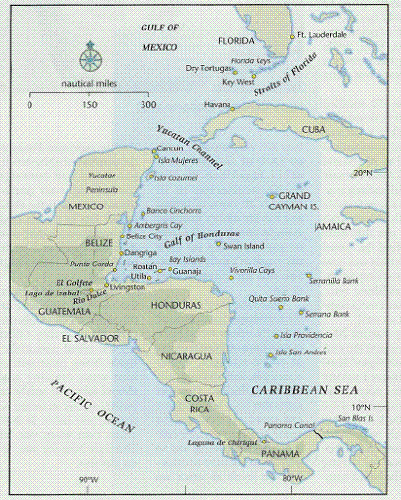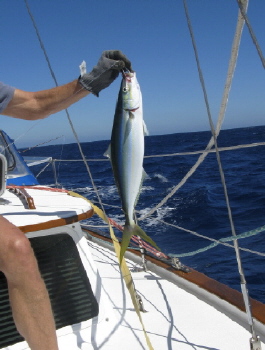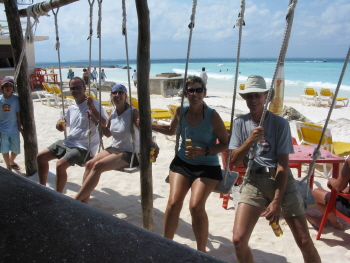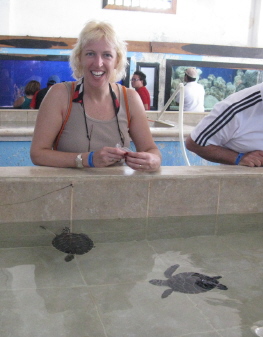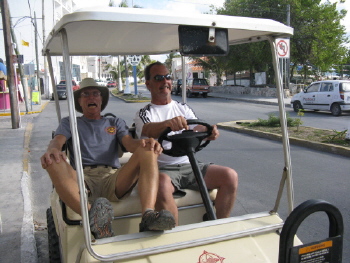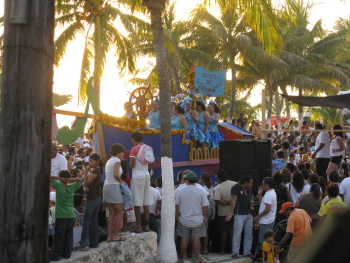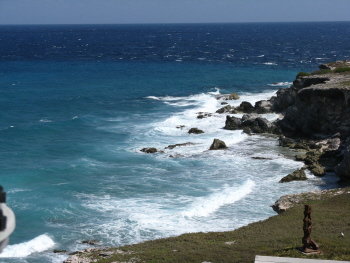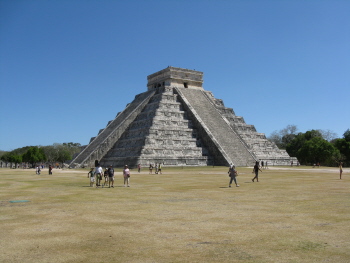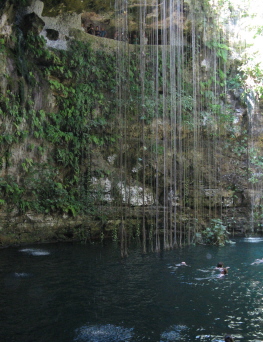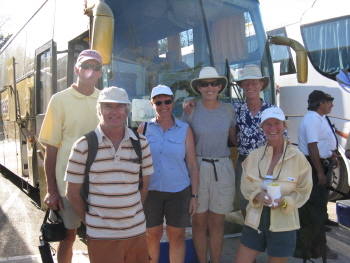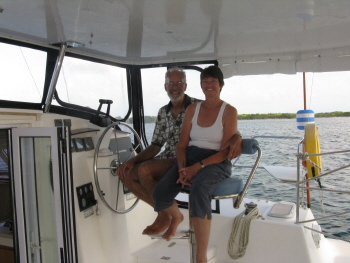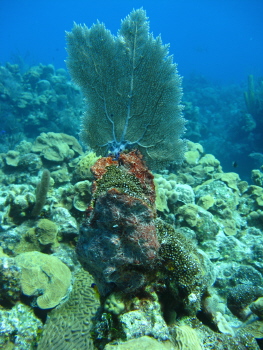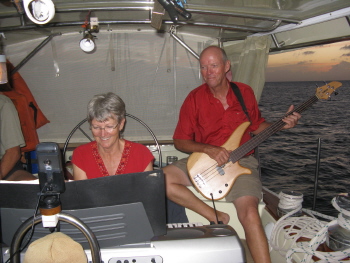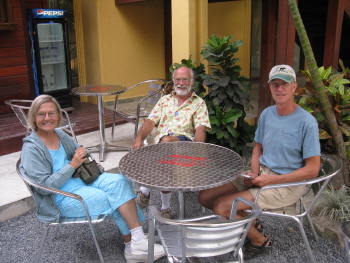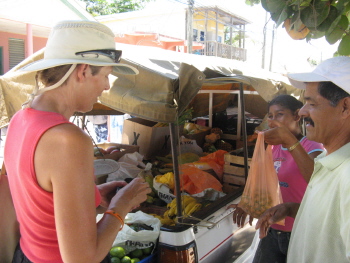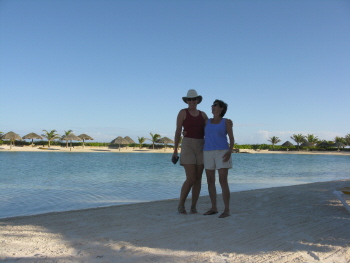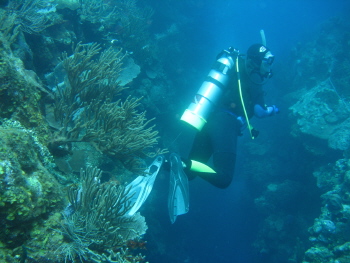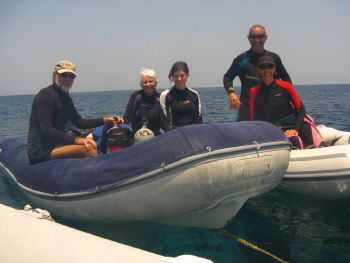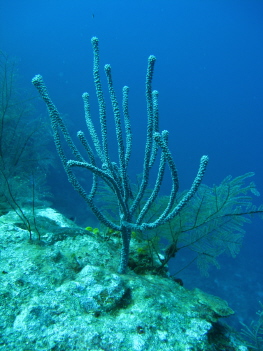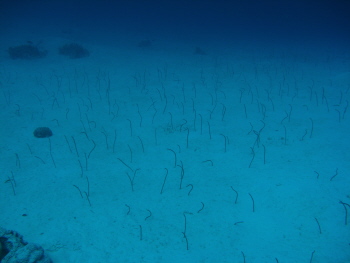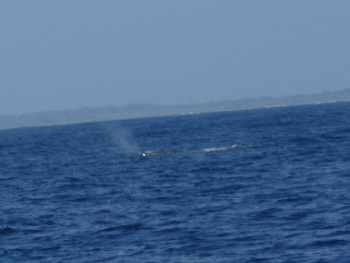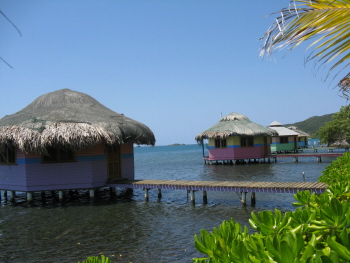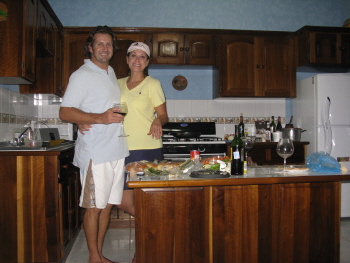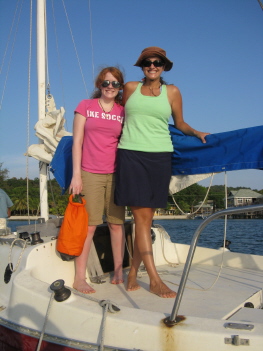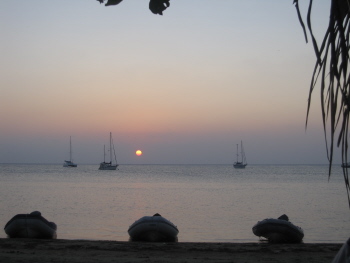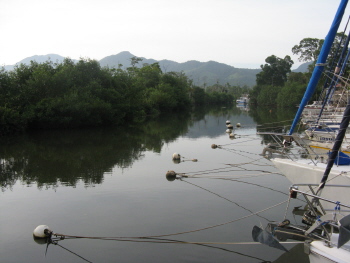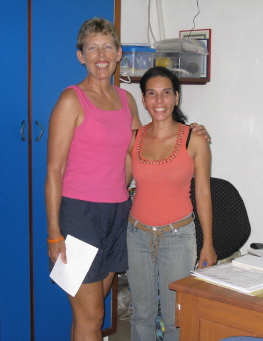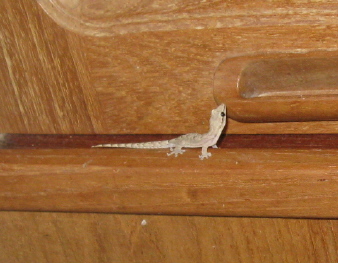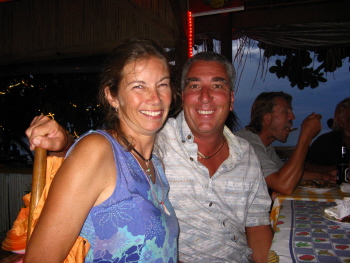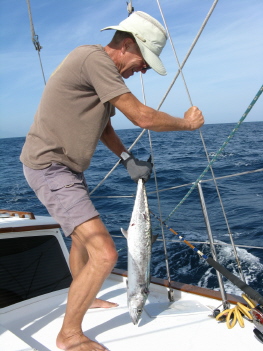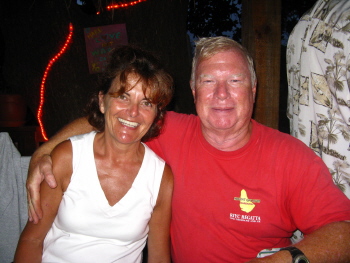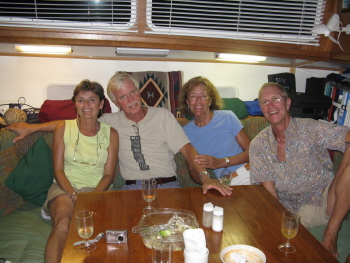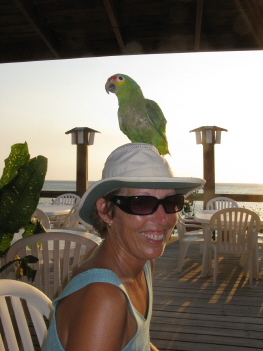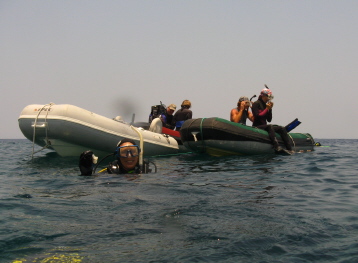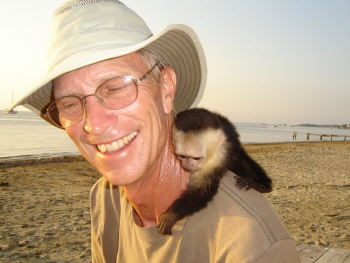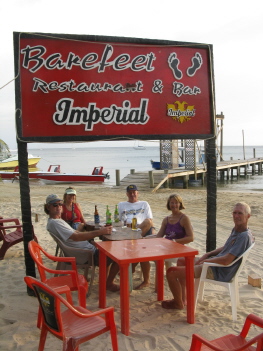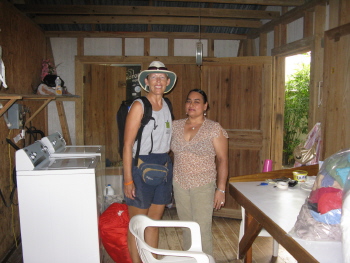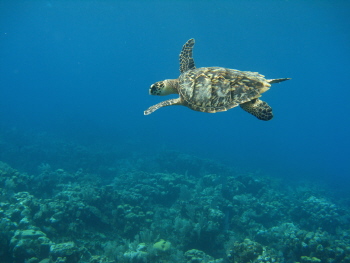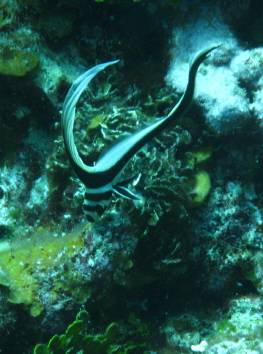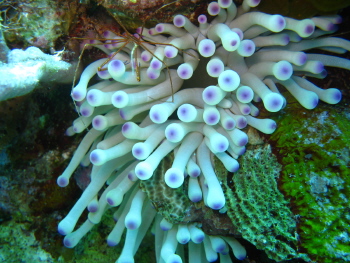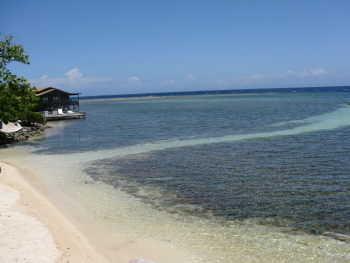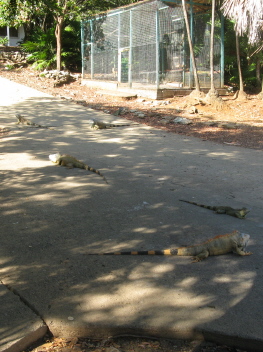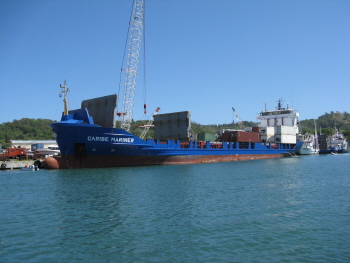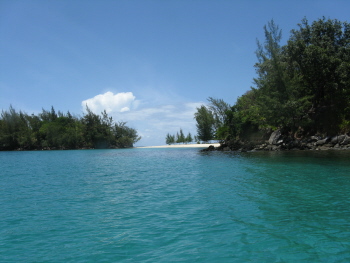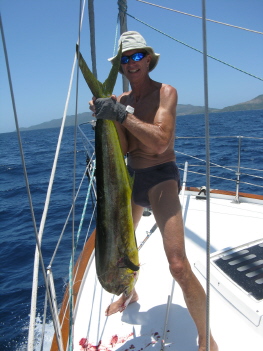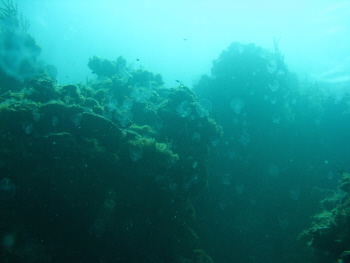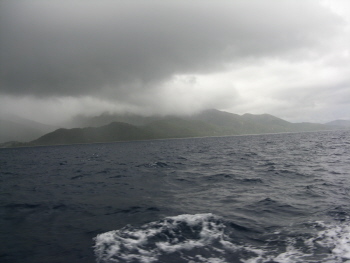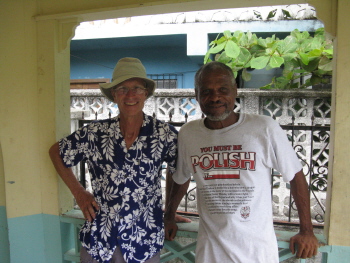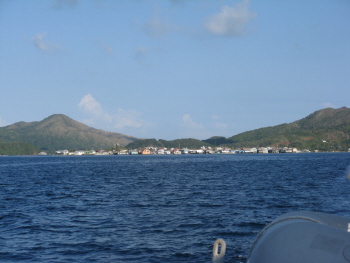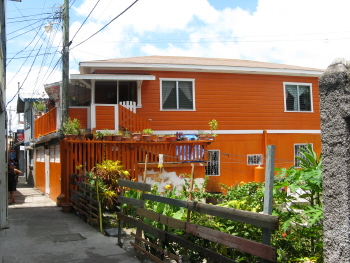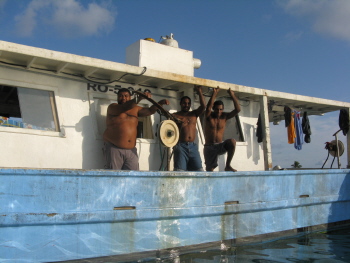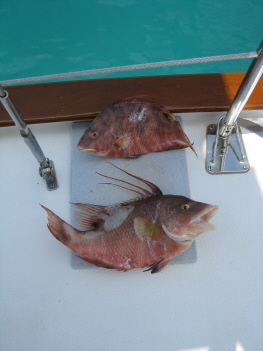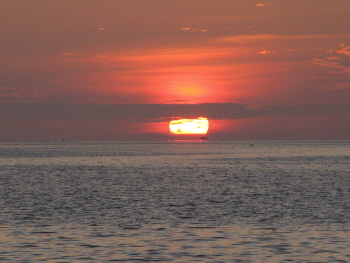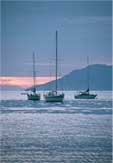
Current Location
(enter callsign KG6NNZ)
Logbook: Mexico, Belize & Honduras - February to May 2009
Our cruising plans for the winter and spring of 2009 had us returning to the Northwest Caribbean where we did some traveling the previous year. In 2008, we cruised in Belize and along the Yucatan Coast of Mexico. This year, we planned to go back to a couple of our favorite spots - Isla Mujeres in Mexico and Lighthouse Reef in Belize - before continuing south to the Bay Islands of Honduras. The scuba diving in this area was fantastic, and we spent a lot of time underwater. We took lots of underwater photos and incorporated some below, but there's also a slide show with many more. To view the slide show of underwater photos, click here.
| Passage from Marathon, Florida, to
Isla Mujeres, Mexico (February 11-15, 386 nm). After waiting 2½ weeks in
the Florida Keys for a good weather window to sail to Isla Mujeres, Mexico, we
were eager to get on our way. While most of the boats departing from Marathon
were headed to the Bahamas, there was a small flotilla headed to the Northwest
Caribbean - Velissa (Bob & Debbie) and Slip Away were headed to Isla Mujeres,
while Bettie (Bob & Kay) and Cloud Walker (Odie & Judy) were
bypassing Mexico and sailing on to the Bay Islands of Honduras. Having had rum drinks with our friends on
Sol Surfin' the night before our departure, we were not the first to drop our mooring and head
out, but since we were planning on a multi-day passage, we didn't feel it was
necessary to get going at the crack of dawn. Before leaving, we
decided to go ashore and use the marina showers since we wouldn't have another one for a
couple of days, and the only time one could get a hot shower at the Marathon
City Marina was first thing in the morning.
We dropped our mooring ball shortly after 9 a.m., passed under the Boot Key Harbor Bridge and stopped at Pancho's Fuel dock to fill up on diesel. By 10 a.m., we were headed out of Boot Key Harbor. Shortly after that, with the wind blowing 15 knots and all sails up, we were scooting along at 7 knots down the Hawk Channel. Yahoo!! Since the weather had been boisterous for the past couple of weeks, seas were still pretty rough outside the reef, but in the Hawk Channel we were protected from the worst of them, and it was a great sail. For some unknown reason, Cloud Walker decided to test the waters outside the reef. They got tossed around quite a bit and had a problem, and they called us on the radio to let us know that they changed their minds and were headed back to Marathon. We said our good-byes, and Bettie, Velissa and Slip Away continued on. As we were sailing past Key West late in the afternoon, our small flotilla started talking about making a stop for the night. There was an anchorage at Boca Grande, about 10 miles beyond Key West. The seas outside the reef were still pretty rough. Traveling inside the reef meant watching for crab pots, which is pretty difficult to do at night. We surely didn't want another experience with running over one of them! The winds were expected to calm down significantly overnight, so we decided to take advantage of an opportunity for a good night's rest. We dropped our anchor at Boca Grande anchorage right around sunset, ate dinner and went to bed early. |
|
| As forecast, the winds laid down
overnight. In fact, they completely died, and the next morning, we motored
away from Boca Grande on glassy calm seas. To avoid heading directly into the
strong current of the Gulf Stream (which was running against us on this trip), we headed west toward the Dry
Tortugas (about 50 miles west of Key West). Once we got to the Dry
Tortugas, we could turn southwest toward Isla Mujeres. Our cruising guide
recommended this route to allow for an easier crossing of the Gulf
Stream. This was the route we used last year, and it worked well, so we
stuck to the same plan. The morning we left Boca Grande, two other boats -
Panacea (John & Patty) and Pelagic (Graeme & Iris) - left the Dry Tortugas
headed for Isla Mujeres. We lost sight of Bettie shortly after leaving Boca Grande, but Velissa and Slip Away were in sight of one another almost all the way to Isla Mujeres. We kept in touch with Bettie, Panacea and Pelagic with a schedule of regular check-ins on the radio. We motored the first 21 hours of the passage, but early in the morning on our second day, the wind picked up and we were able to sail. That same morning, a pod of dolphins swam and played around Slip Away. These dolphins were especially playful, several of them jumping completely out of the water, as they swam along with us. One jumped high in the air just off our bow, so close that Jan was afraid he was going to land on our deck! That afternoon, our fishing line went off and Rich started reeling in a dorado, but the darn fish spit out the hook just as we got him to the boat! We were also dragging a hand line and got a hit on it at the same time. This one didn't get away, and we landed a rainbow runner, which our fish book told us was excellent eating (and it was). Yum! We sailed the better part of the next two days, but the engine came back on when the winds faded and the adverse current picked up as we crossed the Yucatan Straits. Panacea was the first of our group to reach Isla Mujeres. They arrived in the late afternoon so they went into the harbor and anchored. Velissa, Pelagic and Slip Away all arrived after dark, so the three of us chose to anchor off the north end of the island and enter the harbor in daylight the next day. We got in around midnight, dropped the hook and enjoyed a good night's sleep. |
|
Isla Mujeres, Mexico (February 15 to March 4). We love Isla Mujeres and were very happy to be back. We were especially excited because we were expecting visitors - Jan's sister Judy and our brother-in-law Fred would be arriving in a few days.
Upon arrival in Isla Mujeres, our first order of business was to check in with the Port Captain and Immigration, which took a bit longer than normal because 15 boats arrived in Isla Mujeres over the weekend. The good weather window brought boats to Isla Mujeres from all directions. We spent most of the entire first day waiting on the authorities, but we made new friends in the process, and we had "no problema" with being on Mexican time.
Our first few days in Isla Mujeres, we needed to run a few errands in Cancun - a visit to the dentist to have our teeth cleaned and a trip to Wal-Mart to restock Rich's blood pressure and cholesterol medications. An added bonus of our trip to Mexico this year was that the value of the American dollar had risen against the Mexican peso. In the past, we were used to an exchange rate of 10 or 11 pesos per $1 US. This year, the exchange rate was almost 15 pesos per $1 US, so we got more for our money. For example, the ferry trip to Cancun cost 70 pesos round trip. Last year, that translated to about $7 round trip. This year, it cost $5.50. Everything was cheaper - groceries, beer, meals at restaurants - great for us, not so good for the Mexicans.
A few days later, Judy & Fred flew in to Cancun. We were in Cancun that morning delivering some packages to a friend, so we met Judy & Fred at the ferry dock on the Cancun side and rode with them to Isla Mujeres. The next few days were filled with fun. We lounged on the beach, visited numerous beach bars, ate at our favorite restaurants (a couple of stops at Bally Hoo's for their fish tacos), tried out some new eateries, and explored the island with a rented golf cart. The timing of Judy & Fred's visit coincided with the Carnaval (aka Mardi Gras) celebration, so the atmosphere on the island was festive with lots of parades and other entertainment. The weather was good but not great. The sun was out, but the wind was blowing pretty hard. Judy & Fred got to experience sleeping on a boat at anchor with the wind blowing 20-25 knots, which is quite different than sleeping in a house when the wind is blowing that hard. The beaches were pretty much sheltered from the wind, and we could enjoy the warmth of the sun there, but the water temperature was a bit chilly, so dips in the ocean were infrequent and quick. Their visit with us flew by and before we knew it they were headed back to the frigid north. Sorry about your luck!
|
|
|
|
|
|
|
Before leaving the Cancun area, one sightseeing trip we wanted to do was an excursion to the Mayan ruins at Chichen Itza. Jan had visited Chichen Itza in 1986, but that was a long time ago, and Rich had never been. The cost for a tour to Chichen Itza was about $60 US per person. We were considering renting a car and driving to Chichen Itza with two other couples; however, Graeme & Iris on Pelagic then stumbled on to a deal where we could go for $10 US per person if we would attend a 90-minute timeshare presentation in Cancun. Graeme & Iris went to the timeshare presentation and didn't get much pressure to buy, so Bob & Debbie (Velissa) and we decided to sign up for this deal, too. What we failed to recognize when we went into this was that Graeme & Iris are Australian and because of the cost of traveling from Australia to Cancun on a regular basis, they were identified as poor prospects early in the game and were out the door in about 90 minutes. It was a different story for Bob & Debbie, who are Canadian, and us from the USA. We both spent four to five hours in our "90-minute" presentation, being pressured by five to six different salespeople and saying "no thanks" at least a million times. We will NEVER do that again!!
The trip to Chichen Itza was good, but it was a very long day. We caught a ferry to Cancun at 6:30 in the morning, were picked up by a van at the ferry terminal at 7, then rode along as they picked up some other folks and finally transferred to another bus at about 8:30. It was almost three hours to the first stop on the tour, a cenote, which is a naturally occurring fresh water well fed by underground rivers in the area. Tourists were welcome to swim in the cenote, however, the guy who set up our trip failed to tell us about this stop on the tour, and none of us had our swimming suits with us. After about an hour at the cenote, we stopped at a restaurant (lunch was included) where we enjoyed a Mexican buffet and a small show of traditional music and dancing. It was early afternoon when we finally arrived at Chichen Itza. Our tour guide Alvaro provided an excellent narrative and description of the ruins (about an hour), and then we had some free time to explore on our own. Although Chichen Itza is an interesting, beautifully restored and well known Mayan site (probably well known due to a higher marketing budget), we've seen others in our travels that were more appealing to us, such as Tikal and Palenque. After wandering around the ruins for a couple hours, it was time to board the bus and head home. It was three hours back to Cancun, and then we got an hour-long tour of Cancun's hotel zone (which looks like Las Vegas) as they dropped off all the other tourists before getting us to the ferry dock for the last leg of our journey back to Isla Mujeres. We finally made it home about 10:30 p.m.
|
|
|
|
After our tour to Chichen Itza, we started looking for a weather window to move on. Although we could have enjoyed hanging out in Isla Mujeres indefinitely, we were eager to continue further south to warmer waters and good scuba diving. We tried to convince Bob & Debbie on Velissa to come to Belize with us, but they had some guests coming in for a visit, so when the weather looked good, we sadly said good-bye to them and the new friends we made in Isla Mujeres, and sailed south.
Passage from Isla Mujeres, Mexico, to Lighthouse Reef, Belize (March 4-6, 256 nm, 48½ hours). We had excellent sailing winds on this passage, and ran our engine only three hours total, most of that at the start of our passage - motoring to the fuel dock, then out of the harbor, then a bit longer to fully charge the batteries. Winds started out fairly light (8-10 knots), but it was enough to sail. Then they built to 15-20 knots from east to northeast, which was about perfect. We were traveling south against a north-setting current, and the northeast winds caused the seas to get a bit rambunctious at times, but all in all, it was a great passage. The only bit of excitement on this passage occurred when a Mexican Navy helicopter circled above us a couple of times off the southern coast of Mexico, but we must not have looked threatening, and they moved on.
Lighthouse Reef, Belize ( March 6-17). We spent a couple weeks at Lighthouse Reef last year, and we were looking forward to stopping here again to do more scuba diving. We also had plans to meet our friends Russ & Ann on Mohini here. Mohini was heading north to Mexico from Honduras, and we were heading south to Honduras from Mexico, so Lighthouse Reef was the perfect place to rendezvous in between. We had a good couple of days with Russ & Ann, diving, snorkeling and swapping stories, before they continued on to Mexico. We then had Lighthouse Reef to ourselves for a few days before Gene & Brenda on Queen Mary showed up. We first met Gene & Brenda in the Vivorillos Cays (Honduran Islands) a couple years ago, and it was great to see them again. A few days later, a couple more boats came into the anchorage - Don & Rosie on Chickcharney and Kathy & David on Pacifica. We'd never met either couple, but like most cruisers, they were very friendly, and we had several fun days of diving and evening socializing with them. We had a "small world" experience upon meeting Kathy & David on Pacifica. The two of them cruised the South Pacific a few years ago, and were good friends with some old friends of ours from Pacific Mexico. On our last night in Lighthouse Reef, we enjoyed a night of music on Queen Mary with Brenda on keyboard and Gene on bass guitar.
|
|
|
|
Lighthouse Reef, Belize, to West End, Roatán (March 17-18, 84 nm, 16 hours). The passage from Lighthouse Reef to Roatán can sometimes be difficult because one needs to sail southeast, and the easterly trade often blow strong at this time of year. When we got a forecast for lighter-than-normal trades, we took the opportunity and moved on to West End, Roatán. We had northeast winds at the start of our trip and were able to sail 6½ hours before they veered just south of east, and we started the engine to motor-sail the rest of the way. It was not a difficult passage, but we did have a couple of middle-of-the-night incidents that got our adrenaline going. During Rich's 8 p.m. to midnight watch, he heard a noise on deck and smelled something funny. Things that go bump in the night tend to elevate our heart rate on a passage, and he grabbed a flashlight and shone it on the deck. A big stinky flying fish had landed on our deck and was flopping around. He knocked it overboard and settled back into his watch. On Jan's midnight to 4 a.m. watch, we were traveling along quite smoothly when she heard what sounded like a small explosion. Heart racing, she throttled back the engine, which woke up Rich, who looked in the engine room and couldn't find anything wrong. She then noticed in the corner of the cockpit that her self-inflating lifejacket had self-inflated. That was enough excitement for the night! Thankfully, the rest of the trip passed uneventfully. We arrived West End early in the morning and were greeted by our friend Roy on Damiana, who helped us secure Slip Away to a mooring ball.
Bay Islands of Honduras. The Bay Islands lie north of the Honduran mainland coast. Utila, Roatán and Guanaja are the three major islands, but there are at least forty other smaller ones. They have a colorful past - originally inhabited by the Payan Indians, conquered by the Spanish (Christopher Columbus was here in 1502), occupied by French pirates, and ruled by Great Britain until 1861 when they were ceded to Honduras. We were surprised to find a number of the local islanders speak English as a result of their history with Great Britain.
The Bay Islands are popular scuba diving destinations, and most of the area has been designated as a Marine Park. Utila is the westernmost island and is popular with backpackers. It's probably one of the least expensive places in the world to earn a scuba diving certification, and there are several dive shops and schools on Utila for doing so. Roatán lies 18 miles northeast of Utila and is the largest of the Bay Islands (24 miles long and about 2 miles wide). Much of Roatán remains pretty rugged, although there are pockets of development as a result of tourism and North Americans who have relocated to the area. Guanaja lies 16 miles east of Roatán and is the least developed. The islands are an extension of an old volcanic mountain range, and Roatán and Guanaja have a couple of peaks over 1,200 feet. They lie in the heart of the Caribbean tradewinds, which usually blow steadily from the east in the 15-20 knot range, but sometimes higher.
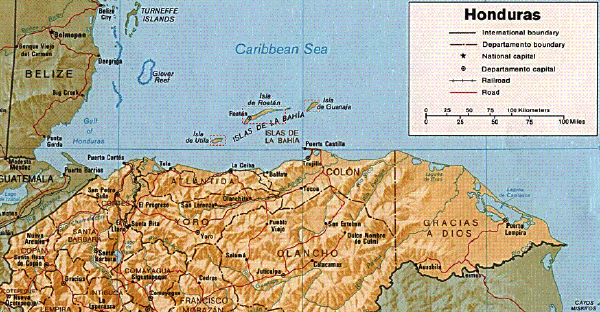 |
West End, Roatán (March 17-21) . We spent a total of two months cruising the Bay Islands and over a month of that time in West End. We loved it here - it was one of our favorite cruising destinations overall. Several times, we moved on to other anchorages but we always found ourselves coming back. The anchorage was spacious and well protected in the prevailing winds, and ashore was a small town with a laid-back island atmosphere, good restaurants, grocery stores and veggie trucks. The great majority of Roatán's dive sites are easily accessible from West End. Roatán's reefs are protected by a Marine Park, so it is prohibited to spearfish or take shellfish, like lobster, crab or conch. The results of this protection are healthy reefs with lots of marine life. Snorkeling and diving was easy at West End, with mooring balls attached to all the dive sites
When we first got to West End, we were looking forward to seeing our friends Roy & Marlene on Damiana, whom we knew from cruising on the Pacific side in Mexico. We were delivering a few items they asked us to bring down for them from the States, and upon our arrival, they graciously introduced us to the area - rode along with us to Coxen Hole to check in with authorities and do some grocery shopping, shared with us some of their favorite restaurants, directed us to the cheapest place to buy Flor de Caña rum and pointed out the best ice cream in town. Within our first few days of arriving in West End, we did some snorkeling and a dive, and we were quite impressed with the diving here. At the Roatán Marine Park Office, we purchased a dive site guide book, which gave us the names, GPS locations and descriptions of all the dive sites around the island, and we used it extensively.
|
|
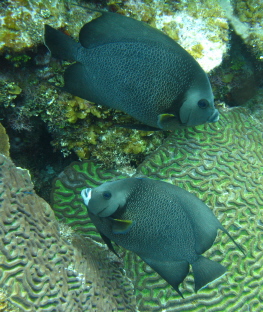 A couple of grey angelfish on one of our dives |
|
After just a few days in West End, the trade winds were forecast to die out for a few days, and Roy & Marlene were headed to French Harbor, which is further east and on the south side of Roatán. We decided to take advantage of this break in the weather and tag along. An added bonus to our trip to French Harbor was an opportunity to see our friends Bob & Maggie on Sea Tryst and deliver the 50 cans of cat food we brought down to their kitty Rosie. Roy & Marlene would be continuing east and then south to Panama from French Harbor, but we planned to come back to West End when the trade winds kicked up again.
French Harbor (March 21-25). With no trade winds, it was an easy motor trip to French Harbor from West End (14½ nm, 2 hours). The town at French Harbor is less attractive and appealing than the town at West End, but we enjoyed exploring it, and French Harbor boasts the best grocery store (Eldon's) on Roatán. We were aware of a highly recommended dive site near French Harbor - Mary's Place - and the calm conditions offered an excellent opportunity for us to dive it. It was outstanding! We also took the opportunity during the calm conditions to dinghy up to Second Bight, where the Parrot Tree Resort & Marina is under construction. We had a couple of friends (Kathleen on Deja Vu and Orin on Antares) who were staying at the marina while their respective spouses were back in the States for a few weeks. Kathleen showed us around the resort, which is quite beautiful and lavish, and we had a fun couple of hours with her. Back in French Harbor, we enjoyed more time with Damiana and also met Alex & Carol on Nepenthe, a boat hailing from Southern California. Alex and Carol are from Torrance, which is quite close to our old stomping grounds of Hermosa and Redondo Beaches. One of Jan's girlfriends from L.A. (Jennifer Waddell) grew up in Torrance, and we found out that Alex went all through school with her. Once again, it's a small world!
|
|
|
After a few days in French Harbor, the trade winds returned and came back strong. Our last night there, the winds blew 20-25 knots, and although a reef protects this anchorage from the seas, the winds can howl through there. We were on a mooring ball, and depending on the direction of the wind, we felt uncomfortably close to either a reef or another boat. We didn't sleep much that night, and early the next morning, we left French Harbor and headed back to West End.
West End, Roatán (March 25 to April 3). When we departed French Harbor, we unfurled the headsail, turned off the engine and had a great sail back to West End (14½ nm, 3 hours). Back in West End, we spent the next ten days diving and hanging out with Insatiable One (Greg, Marilyn and their visiting grand-daughter Jessica) and Tides End (Reg & Gail). Alex & Carol on Nepenthe also came to West End from French Harbor, and they joined us for a few dives and social evenings as well. Each morning, we would pick a site out of our Roatán Dive Guide and go check it out. Sometimes we'd go back to a favorite, such as Mandy's Eel Garden, Canyon Reef or Gibson Bight.
|
|
|
|
As April approached, Insatiable One and Tides End began making plans to take their boats to the Rio Dulce in Guatemala, where they store them while they return home to Canada for the summer. From West End, they would sail to Utila, the westernmost of the Bay Islands, and from there, they would continue on to the Rio Dulce. We'd been hearing reports of whale shark sightings on Utila, so we decided to tag along with them in that direction.
| Puerto Este, Utila (April
3-6). We left West End with a forecast of 15 knots of winds from the
southeast, so we thought we would have a good sail west to Utila. However,
the actual conditions were light southwesterly winds, so we ended up motoring
(24 nm, 4 hours). Before pulling into port, we took a small detour and motored along the east coast of Utila looking
for whale sharks because we were told that's where they had been sighted, but no
joy.
We spent a few days in Utila, enjoyed some additional time with Insatiable One and Tides End, and found some excellent snorkeling just outside the main harbor. We also signed up for a "Sunday Fun Day" dive trip with the College of Diving. Another cruising couple had done this the previous week and told us of their wonderful experience swimming with the whale sharks. Although we had a good day of diving, the whale sharks eluded us once again. When we said good-bye to Insatiable One and Tides End, we headed back to Roatán. Semana Santa (Holy Week) had arrived, and this is the biggest holiday week of the year in Central America. The locals head to the beaches and party down for Semana Santa, and the celebration had already started in Utila. Latinos like their music loud, and they stay up much later than we normally do, and during our last couple of nights in Utila we had music blasting in the anchorage until the wee hours of the morning. We were in search of a quiet anchorage, and several of our cruising friends were headed to Port Royal, which is a bay on the south side of Roatán with no roads leading to it and only one small fishing resort ashore. We decided to go there, too. Additionally, the weather forecast was calling for a "norther" in a couple of days, and Port Royal would provide good shelter for that. |
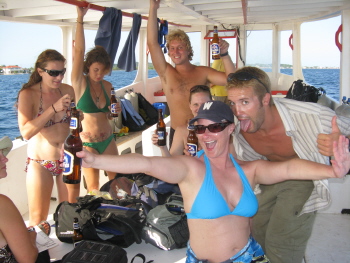 Post-diving party on the College of Diving's Sunday Fun Day dive trip. No doubt, we were the oldest people on this trip! |
Port Royal, Roatán (April 6-13). We departed Utila with light winds and motor-sailed toward Roatán. We again searched for signs of the whale sharks but found none, but we did see a whale! We don't know what kind of whale it was, but it was just hanging out on the surface "spouting off." We tried to get a closer look, but it dove down when we approached it. Although we were bummed that we missed the whale sharks, seeing a whale was a reasonable consolation. We motored most of the way to Port Royal (38 nm, 7 hours) although we did have about 1½ hours when we were able to turn off the engine and sail with our spinnaker.
Our first couple days in Port Royal were quite fun - reconnecting with old friends, meeting new ones and getting to know the folks who run the Mango Creek fishing resort (ex-cruisers who circumnavigated). The weather was fairly settled, with the exception of the passing cold front which brought rain and high winds, but that only lasted a few hours. After those first couple of days, the weather forecast called for strong southeast winds. We didn't think Port Royal would be a great anchorage in those conditions, but when we talked with one of the owners at Mango Creek about moving to the north side of Roatán, he convinced us that the beaches along the north coast would be overrun with drunk Hondurans celebrating Semana Santa. We were ambivalent about leaving because so many of our friends were here in Port Royal, and his comments made us change our minds and decide to stay.
|
|
|
When the southeast winds started blowing, they blew hard. When we first arrived, we set our anchor facing into the north winds which were blowing at that time. We should have re-set our anchor for the change in conditions, but when we checked the anchor, it was buried and we didn't want to disturb it. That turned out to be a bad decision, but fortunately it caused us no great harm. On Friday night (these things always happen at night) when the winds were gusting 30-35, our anchor started dragging. Fortunately, Rich was up in the cockpit, noticed it right away, and we very quickly got underway and reset our anchor in the right direction, and it held for the rest of our time there. We were very lucky - a few hours earlier, we were having dinner with friends at the Mango Creek resort. If we hadn't been on the boat, Slip Away could have dragged on to the beach. Lesson learned... For the next few days, the winds would blow hard all night long (25-30 knots), but by morning they would usually lighten up to 15 knots, and we would be lulled into thinking that conditions were improving, but each night we had more of the same. This inertia appeared to affect all of the cruisers in this anchorage, as none of us could get motivated to seek out a different anchorage. Perhaps we weren't able to think clearly due to lack of sleep, but we all seemed to think that a windy and uncomfortable anchorage was better than a loud and rowdy anchorage with Semana Santa revelers ashore.
On the Monday after Easter Sunday, the Port Royal anchorage emptied out. As we settled into anchorages with better protection, we were all asking ourselves "Why didn't we move sooner?"
West End, Roatán (April 13-15 and 17-20). When we left Port Royal, there was no question in our minds as to where we were headed - back to West End. We knew West End would be well protected from these strong tradewinds which were forecast to continue indefinitely. We pulled out of the Port Royal anchorage, unfurled our headsail, and sailed the distance back to West End (22½ nm, 4½ hours).
We spent the next week anchored at West End and were back to sleeping well at night and enjoying the cruising life. Maggie & Bob on Sea Tryst and Cindy & John on Tashmoo joined us at West End a couple days later, and we had fun diving and hanging out with them. We also found ourselves spending quite a bit of time in the ice cream shop - Cream of the Trop - which had not only delicious home made ice cream and excellent breakfast (the best French Toast we'd ever had), but also wireless internet, air conditioning and very friendly owners - Serena and Bill from Houston. We ended up inviting Bill, Serena and her daughter Lauren to Slip Away for dinner a couple times, and they invited us to dinner at their home in Flowers Bay on Roatán.
|
|
|
|
Big Bight, Roatán (April 15-17). Big Bight is on the north side of Roatán about 13 miles east of West End. It's quieter and more secluded than West End, and we'd heard good things about it, so we were watching for a break in the tradewinds to go check it out. When the tradewinds lightened up for a day, we took the opportunity and motored off to Big Bight (2½ hours). Winds were still from the east ("noserlies"), but they weren't too strong, so it wasn't a bad motor trip. And, we caught a big wahoo on the way!
We had a couple of nice days to ourselves at Big Bight. The anchorage was beautiful and the snorkeling was outstanding. We also did a dive from Big Bight, and it was a pretty dive site. However, visibility wasn't as good as we were used to at West End, and there was some current that made us uncomfortable. After a couple of days, the tradewinds picked back up, and the anchorage became less comfortable, so we weighed anchor, unfurled our jib and had an excellent sail back to West End. When we arrived in West End, we shared our wahoo catch with several friends. We were quite popular!
La Ceiba, Mainland Honduras (April 20-25). Although we weren't looking forward to heading into the town of La Ceiba on the mainland, we needed to spend a few days there. With the high cost of healthcare in the U.S., we usually seek those services in other countries where prices are much lower but good care is still available. When we attended the University of Miami health fair in the Florida Keys, the doctor who did the dermatology exam on Rich identified a few spots he thought should be checked out more thoroughly. Additionally, it had been a couple of years since Jan's last mammogram, and Jan also needed to see a dentist about a tooth that was bothering her. We had first-hand knowledge of a good dentist in La Ceiba - one we had visited two years ago. We also had a recommendation for a good dermatologist, and mammograms were available at the local medical center. This was also a good opportunity to do some provisioning. Our food supply was starting to run low, and since we needed to purchase some large quantities, it was worthwhile to do some shopping in La Ceiba, where selection is somewhat better and prices tend to run a bit lower than in the islands.
There's no good anchorage near La Ceiba, so our choices were to go into either Lagoon Marina or the dock at the La Ceiba Shipyard. We stayed a Lagoon Marina two years ago and really liked the marina and the folks who ran it, and since the cost was about the same as the shipyard, we opted for the marina. The setting of the marina is quite beautiful - in the jungle with mountains in the background and beautiful bird songs, especially in the morning. Our return to Lagoon Marina was bittersweet, however. The marina was started by a German couple, Toni & Rita Vorleiter, and Toni was murdered just over a year ago. Rita has continued to run the marina with the help of a new marina manager named Greg.
Rita was out of town during this stay at Lagoon Marina, but her assistant Rosie welcomed us back and took good care of us. She scheduled our appointments and gave us maps with explicit directions for all of our errands. Our medical appointments went well - mammogram all clear, several spots frozen off Rich's skin but nothing too serious, and a small filling in Jan's tooth. La Ceiba is a fairly good-sized city with some American restaurants, and we couldn't resist the temptation to eat lunch at Pizza Hut one day. We spent money at all the big grocery stores in town, even finding one that sold Kirkland (Costco) and Member's Mark (Sam's Club) brands in the same store. The marina delivered cases of beer and soda to the boat, and a few days later, we were stocked up and headed back to the islands.
Spending time at a marina always comes with the risk of picking up hitchhikers. Cockroaches, rats and even snakes are known to climb up docklines and find homes on boats. Fortunately, we've managed to avoid those varmints, but shortly after leaving Lagoon Marina, we found a stow-away - a gecko. Geckos can be good since they eat bugs, and lots of cruising boats have them aboard. We welcomed our new pet, named him "Gordie" and told him he could stay as long as he didn't crawl on us in the middle of the night. So far, he's honored that request. We occasionally find him wandering around inside and out on deck, and he even showed himself during a happy hour gathering of friends on Slip Away. He's only gotten in trouble once - when Jan found him gnawing on her half of a banana, but even then, he didn't eat much.
|
|
|
|
West End, Roatán (April 25-May 12). When we departed Lagoon Marina, we once again headed back to West End. Our friends Bob & Maggie on Sea Tryst and Cindy & John on Tashmoo were still there, and we wanted to spend a bit more time with them before we headed off in different directions for the summer. The seas were a bit rough on our passage back to West End, but we motor-sailed it (33 nm, 6 hours) and caught a nice-sized mackerel on the way, which we cooked up for dinner one evening with Sea Tryst and Tashmoo.
|
|
|
|
Sea Tryst and Tashmoo left West End a few days later, but we stayed on for a couple more weeks. We got into a routine - diving most days, attending the Barefeet Barbeque every Sunday, buying fresh fruits and veggies from the veggie trucks every few days and making numerous trips to the ice cream shop. We made some new friends, and most days one could find us and Nick & Deanna on Caribbean Soul heading out together to a dive site. When we were having a problem with our freezer not running cold enough, our friends at the ice cream shop called their refrigeration guy, who came out to Slip Away, recharged our system and fixed it. We kept thinking about starting to work our way east so that we could then head south to Panama, but the prevailing easterly trade winds continued to blow strong, and we stayed put.
|
|
|
|
|
|
|
|
And, a few more underwater photos:
|
|
|
|
Although we would have liked to hang out in West End a couple more months, when there was a break in the trades, we moved on. Hurricane season was approaching, and for insurance coverage, we needed to get further south. In mid-May, when the trade winds finally lightened up, we sadly left West End and started to work our way east.
French Harbor, Roatán (May 12-14). Our first stop after leaving West End was French Harbor (15 nm, 2½ hours), where we intended to fuel up and pick up a few provisions. Eldon's grocers had recently opened a new store, it was the talk of the island, and we couldn't leave without checking it out. Shopping there is not so different as shopping at a store in the U.S. We hoped to dive Mary's Place once more, but the weather wasn't settled enough this time, so we had to pass on it. Instead of diving, we visited the local iguana farm - we'd never before seen so many iguanas in one place! We also enjoyed happy hour at the Coco View Resort, where we found a good wi-fi internet signal and met a really nice guy who bought our drinks in the hopes that we would help convince his wife that they too should travel the world in a sailboat. (Unfortunately for him, I don't think we succeeded!)
Fueling up at Hybur's dock in French Harbor ended up being more of a challenge than anticipated. Hybur's is not only a fuel dock but also an unloading dock. When we walked over to their office to arrange for our fueling, they told us to come in the next morning because they were expecting a big ship for unloading in the afternoon. The big ship came in early, and when we showed up the next morning, he was taking up the entire dock, with plans to be there all day. We ended up anchoring just off the fuel dock, and Rich jerry-jugged 82 gallons of diesel, 12 gallons at a time.
|
|
|
|
Port Royal, Roatán (May 14-15). With the delay in fueling, we departed French Harbor later than anticipated, but it was early enough to get a bit further along the island, and we motored up to Port Royal (12 nm, 2 hours). Although we only stopped to spend the night in Port Royal, it gave Jan the opportunity to deliver some cookies to a nice guy named Ralph who was caretaking a house here and had let us use their wi-fi internet service during Semana Santa. On our way to Port Royal, our wind generator started making awful sounds and once again stopped feeding amps into the batteries. Rich climbed to the top of the mizzen mast and tied it off. Our Fourwinds Red Baron wind generator is likely headed to a watery grave.
Isla Barbaretta (May 15-16). Although the easterly tradewinds had died down quite a bit, they were still blowing 10-15 knots. Since we had to motor into the wind to get where we were going, we took small steps, and from Port Royal, we made another short hop to Barbaretta (10½ nm, 2 hours). Isla Barbaretta is a privately owned island, and the anchorage was settled and protected from the winds. We arrived in the early afternoon and went out for a snorkel. Visibility wasn't great, but it was good to be in the water, and we enjoyed the fish sightings, especially a bunch of juveniles in one area. We spent just one night here before continuing east to Guanaja.
Guanaja
Guanaja is the easternmost of
Honduras' Bay Islands, and lies about 15 miles east/northeast of Roatán.
Christopher Columbus discovered Guanaja in 1502 on his fourth and final voyage
to the New World on the ship Admiral of All Oceans. Columbus called
Guanaja "Pine Island" because it was covered by Caribbean pine trees. In
1991, Category 5 Hurricane Mitch slammed into Guanaja and destroyed most of the
pine forest that covered it. The island has recovered significantly since
then, however, we still saw quite a few bare tree trunks - no bark or limbs -
remnants of that hurricane of 18 years ago. Guanaja has a
population of about 10,000, and about 8,000 of them live on a small island (Bonacca
Town) in the main harbor. Guanaja is the most isolated and therefore the
least touristy of the Bay Islands
Michael Rock (May 16-19). From Barbaretta, we headed to Michael Rock, on the north side of Guanaja (19½ nm, 4 hours). The winds and seas were calming a little each day on our easterly trek, and we had only 10-12 knots of wind on our nose and 2-3 foot seas for this trip. About an hour into this passage, we decided to put out our fishing line. Not more than 20 minutes later, we had a big hit on our lure, and Rich landed a 52" mahi mahi. She was a strong fighter, and he was plum tired after reeling her in! We ate mahi mahi for a few days in a row and put several more meals in our freezer.
Michael Rock is a beautiful anchorage, and we had it all to ourselves. There are several excellent dive sites nearby, and we did a couple of dives. Unfortunately, visibility was really poor during the time we were there. We were used to 80 to 100+ feet of underwater visibility at West End, and we were finding only about 30 feet of visibility here. We talked on the radio to our friends on Caribbean Soul who had gone from West End to Lighthouse Reef in Belize, and they were experiencing similar conditions. We don't know what caused it (maybe a plankton bloom), but it was really disappointing. A dive site called the Pinnacle was recommended to us, and we dove it, but in addition to the poor visibility, there were lots of jelly fish in the water. The jellyfish were not a stinging variety, but they still made us feel uncomfortable. We could tell that under different conditions, this would have been an outstanding dive. After our morning dive at the Pinnacle, we decided to go for a hike. Other cruisers talked about a great hike to a waterfall, and our cruising guide provided vague directions. We never found the waterfall, but we did enjoy a nice hike on the island.
|
|
|
|
Bonacca Town (5/19). On our last morning at Michael Rock, we awoke early and quickly got underway. There was a squall approaching from the north, and the change in wind direction put us uncomfortably close to shore. At 5:30 a.m., we weighed anchor and departed. Honduras does not go on daylight savings time, so it was already light, and we were able to safely navigate out of the anchorage and channel. We motored around the east end of the island to approach the El Bight anchorage near Bonacca Town. By the time we arrived, the squall had passed, and we had good visibility to enter El Bight (17 nm, 2½ hours).
It was a good thing that we had gotten an early start that day because we had a lot to do. We were planning to leave Guanaja the next day and start working our way to Panama. Bonacca Town was our last port of call in Honduras, and we needed to visit the Port Captain and Immigration to do our clearing-out paperwork. Also, since our travels from here would take us into more remote areas, we needed to restock fruits and veggies and a few other items.
As we dinghied to the dock near the Port Captain's office, we were greeted by "Hondo," who helped us find a place to tie up and pointed us in the right direction. The clearing out process with the Port Captain and Immigration took only a few minutes, and afterward Hondo offered to take us on a tour of Bonacca Town. Hondo spoke excellent English (he lived in New Jersey for a number of years), and his tour price was reasonable, so we said OK. It took about an hour for Hondo to show us around and tell us a little history of the island. The tour was interesting and informative, but we couldn't help but roll our eyes when he kept referring to Guanaja as the "eighth wonder of the world." After our tour, he took us to the veggie market and a store that sold freshly baked bread (some of the best bread we've ever had!) and even showed us a place where we could sit with our laptop and pickup a wi-fi signal to download our internet email. He also directed us to a smaller adjacent island where we could buy diesel and fill our empty propane tank. He was very helpful.
|
|
|
|
|
|
After a long morning in Bonacca Town, we returned to Slip Away and started stowing our provisions. After lunch, we dinghied our diesel jerry cans and empty propane tank to the fuel dock to get them filled. After the fuel and propane were pumped, we spent another hour on the dock because a big squall came through and dumped a ton of rain. It took Rich about 15 minutes to bail out the dinghy with our water cannon after the rain finally stopped. We only had one bailer, so Jan could only offer moral support.
Once back on board Slip Away, we finished stowing everything in preparation for our passage the next day and settled in to get some sleep. It was a windless and buggy night. Jan went to bed early, sleeping in front of a fan and covering up with a sheet, and she managed to avoid getting a lot of bites. Rich sat up in the cockpit reading for a couple of hours before going to bed, and he nursed numerous bug bites for the next several days.
Passage to Cayos Cajones (the Hobbies), Honduras (May 20-21 - 161 nm, 26 hours). We had one final eastbound passage to make before we could turn south. From Guanaja, we were headed to Cayos Cajones (locally known as "the Hobbies"), a small group of islands off Cabo Gracias a Dios, the "corner" at the border of Honduras and Nicaragua.
We were anticipating this passage with some anxiety because it can be notoriously rough. In 1502, when Christopher Columbus and his crew traveled this stretch of ocean on the Admiral of the Ocean Sea, they tacked back and forth for 28 days before reaching Cabo Gracias a Dios, which translates to Cape "Thanks to God," the words Columbus reportedly uttered when they finally arrived. When we traveled west along this stretch of ocean two years ago, we sailed downwind with 35 knots of wind and seas that ran up to about 10 feet. Although we have the advantage of an engine over Christopher Columbus, we definitely didn't want to be motoring into conditions like that. We had been watching the weather all week, and our forecaster advised us that a system further north of us was killing the trade winds. He assured us of an easy passage, and he was right. We never saw more than six knots of wind. There was a bit of ocean swell making the seas somewhat rolly at times, but we put up the mainsail, which helped to stabilize the boat. Squalls followed us most of the first day, but they never overtook us. We caught another mahi mahi while underway, but this was a little one, so we threw it back. We arrived at the Hobbies early the next morning, having slowed down in the last few hours of the trip to ensure an approach in daylight. As expected, we had to motor the entire way, but it was about as easy a trip as one could ever hope for on this passage.
Cayos Cajones (the Hobbies), Honduras (May 21-25). The Hobbies are a very remote group of islands. They are not mentioned in any of our cruising guides and they are not well charted, but other cruisers have gone there before us and provided waypoints. The fishing was reputed to be the best around, and we heard tales of a "snapper hole" where one could just sit and wait for a fish to swim in front of one's speargun. We had hoped to travel to the Hobbies with our friends Tom & Cathy on Jumbie, but they had a broken down generator and were awaiting delivery of a part back on Roatán. Not wanting to miss the good weather window, we traveled solo.
When we arrived at the Hobbies, we had two anchoring waypoints from two different cruisers, and they were about a mile apart from one another. The first waypoint was near an island, with a Honduran fishing boat anchored nearby playing loud music and a couple barking dogs on the island. We quickly moved to check out the other recommended anchorage, which was far from any land, but protected by reef, and with the light winds, it was peaceful and calm.
We spent four days in the Hobbies. We did a little snorkeling on our first day, but although the winds were extremely calm, visibility wasn't great, and we didn't see much. The next day, we went in search of the snapper hole. We had a waypoint from another cruiser, Rich had his new speargun in hand, and Jan took a pole spear. We anchored the dinghy inside the reef and swam through an opening in the reef to find the snapper hole. Although there weren't any snapper swimming in front of our spears, we did see a few big ones. Unfortunately, since a number of cruising boats had been through this area over the past few months, these fish had probably been shot at quite a few times and knew to be leery of us. There was one big dog snapper that headed for a hole in the reef the moment he saw us. He came out a few times, but didn't venture far, and when he saw we were still there, he quickly turned around and headed back into his hole. The rubber band on Jan's pole spear broke the second time she took a shot at a fish, so it was up to Rich to bring home some dinner. He was successful, shooting a couple of hog fish, which is one of our favorite. The new speargun was getting broken in, and Rich had lost his "hogfish virginity." Since there were sharks and barracudas in this area, as soon as Rich shot a fish, he swam it back to the dinghy. Although Jan's pole spear wasn't functioning to shoot fish, she swam along with Rich and stood guard, intending to poke at anything that tried to steal our catch from us. She didn't have to fend off any attackers, although our heartbeats did quicken at one point when we saw a nurse shark swimming along the bottom about 20 feet below us. Fortunately, the shark either didn't see us or wasn't hungry.
We returned to the snapper hole each day over the next few days, but the fishing was just so-so. Visibility continued to be not so great, and the fish continued to be skittish. Jan succeeded only in terrorizing the fish with her pole spear, shooting at them, but never managing to hit one. Rich had more success with the spear gun and got a Spanish grunt and dog snapper (but not the big one). We made friends with the fisherman near the island, taking them some cold beers on an especially hot and wind-less day. We took their picture, then printed out a copy for each of them and took the copies back to them the next day. When we returned with the photos, they asked if we had any cigarettes. We had been advised by other cruisers to take cigarettes to trade with the fishermen, so we had picked up a couple of packs in Guanaja. When we returned with the cigarettes, they gave us a bag of fish and conch, so we had plenty of seafood for the next few days.
|
|
|
|
Cayos Vivorillos, Honduras (May 25-26). After a few days in the Hobbies, the weather forecasts were indicating that the trade winds would be returning shortly, so we made plans to move on. When we left the Hobbies, we first made a short passage to the Vivorillos, another group of remote islands, and we had a beautiful sail under jib and jigger (headsail and mizzen) in about 15 knots of wind (17½ nm, 3½ hours). When we anchored in the Vivorillos, the water looked a bit cloudy here too, so we decided just to spend the night and move on the next day.
The Vivorillos was our last stop in Honduras. When we left the Vivorillos the next morning, we were headed south toward Panama, intending to probably stop somewhere in between, but with no definite destination in mind.
A couple of weeks after leaving Honduras, we heard on the news that their government was overthrown by a military coup. We have no idea what the future holds for this Central American country, but it has a lot to offer and we hope that their government stabilizes and provides them with good leadership. Protecting their fish and conserving their coral reefs under their park system is one thing they are doing right. We left Honduras with wonderful memories and hope to return some day to find it thriving and continuing to progress.
